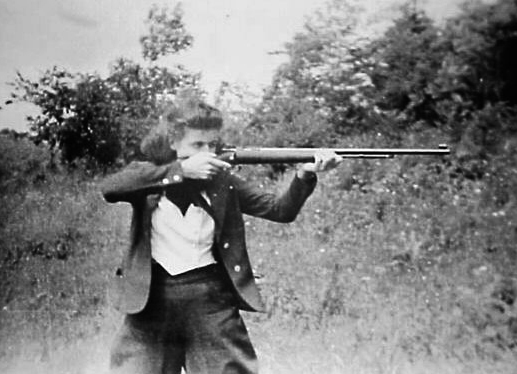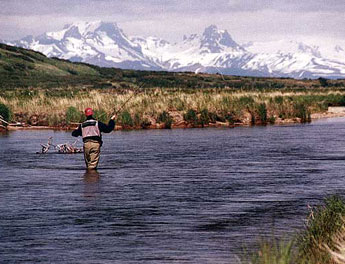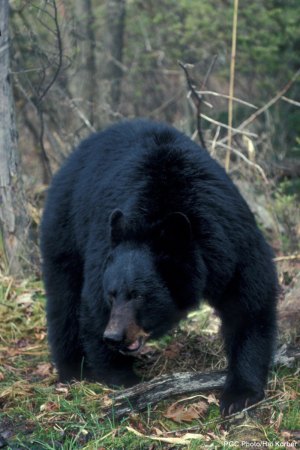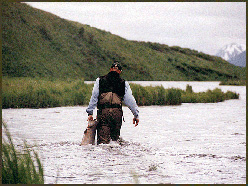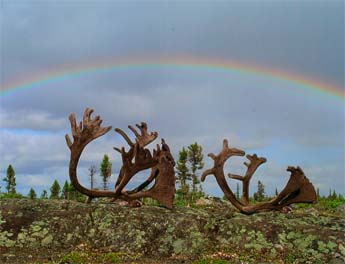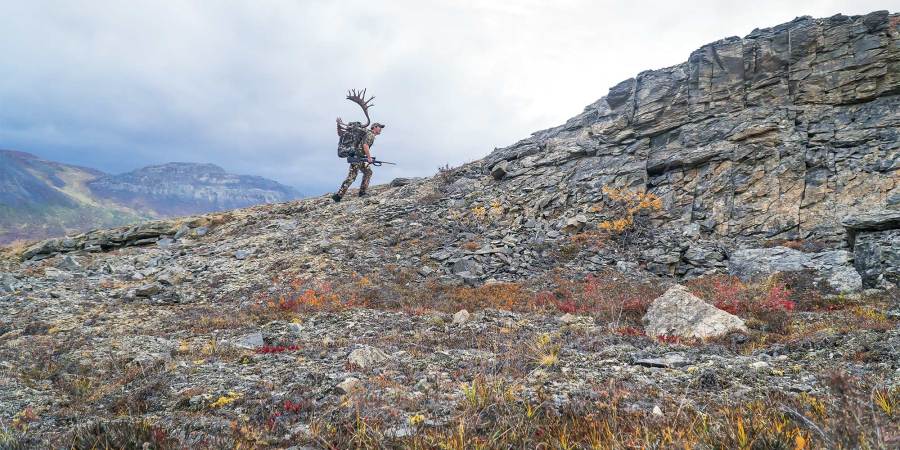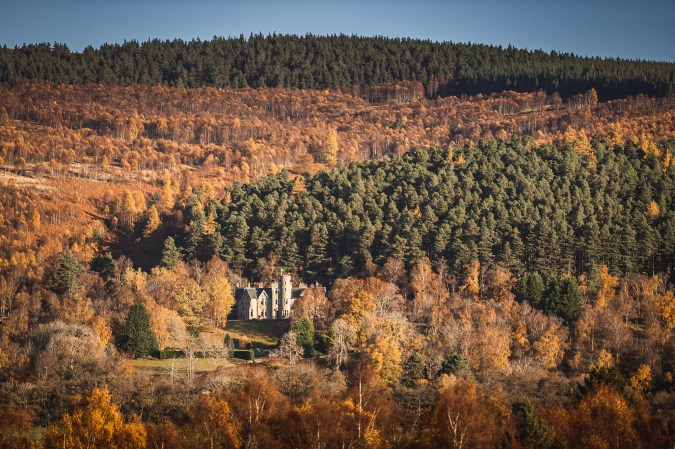Alaska. It’s the hottest hunting and fishing destination in the world, comprising more than 585,000 square miles of forest and coast, volcanoes and glaciers. Here, the barren-ground caribou outnumber human residents. In this realm of dependable adventure, the fish, game and wilderness are always super-sized. But the wild places of Alaska are also very personal, calling to each of us in a voice that speaks to our individual yearnings.
Choose your backdrop of scenic mountains or endless arctic tundra with winding rivers as clear as crystal. The spruce-scented air is so pure you’ll feel born again, discovering the outdoors with the wonder of a child. The sheer size and abundance of the state create the perfect recipe for success. But don’t take my word for it. Check it out yourself.
“Alaska is one of the top destinations,” says Ken Shapiro, editor-in-chief of TravelAge West, a leading travel industry magazine. “It’s exotic but familiar at the same time. It’s wild but has a solid infrastructure. And it lends itself to the kind of experiential travel that sportsmen are looking for these days. It’s just got everything a sportsman wants.”
Here’s a look at 10 of the state’s most exciting adventures. You owe it to yourself to try at least one.
Big Adventure on the Copper River Valley and at Wrangell–St. Elias
The Klutina River boasts some of the wildest king salmon fishing in the world. Anglers employ 60- to 80-pound-test line to battle 30- to 50-pound kings hooked in current that pushes along at 5 to 15 mph. You have to fish choice runs quickly, before the flow sweeps your inflatable raft along steep canyons that wind against a backdrop of volcanoes and some of North America’s largest mountains.
The Klutina is adjacent to the Wrangell–St. Elias National Park and Preserve, the largest in the United States. On one fly-out, I hooked rainbows weighing as much as 6 pounds, and at another lake I enjoyed nonstop action for 10- to 16-inch rainbows on dry flies. Do as I did: At 2,500 feet, just sit by your rental cabin and enjoy the crackling of the fire. Observe the bears and mountain goats and take in Alaska’s spectacular autumn alpine scenery.
Between fishing trips, drive the back roads to view the remnants of the gold and copper rushes of the early 1900s: old railroad engines, ghost towns and haunted roadhouses. Explore the waters along the scenic Denali Highway for lake trout and grayling and the Gulkana River for king salmon and trout.
AVAILABLE SPECIES: Salmon; steelhead; char; cutthroat, lake and rainbow trout.
BEST MONTHS: June through September are ideal, with July the optimum time to fish for king salmon.
ACCESS: Fly by commercial air to Fairbanks. Rent a car and drive the Richardson Highway south to Gakona or make the ferry connection to Cordova.
TACKLE AND EQUIPMENT: Heavy-action, 7-foot rods with levelwind reels and braided line work well. Guides provide gear.
OTHER ACTIVITIES: Gold Rush relics of the early 1900s abound. Take scenic tours to Valdez and the old Kennicott copper mine. Grouse, ptarmigan and snowshoe hare hunting are also seasonally available.
COST: A 10-hour fishing day is $259 per person. Gakona cabins will run you $125 a night.
CONTACT: Copper River Salmon Charters, 888-462-3221, gakona.com; Gilpatrick’s Hotel Chitina, 907-823-2244; Kennicott Glacier Lodge, 907-258-2350, kennicottglacier lodge.com; Orca Adventure Lodge, 866-424-6722, orca adventurelodge.com.
Call Up an Innoko Moose
The Innoko National Wildlife Refuge offers the world’s best moose hunting. Scrape a little with a scapula, but watch out! On my last hunt, a rutcrazed bull with a 72-inch-wide rack emerged from the brush with bloodshot eyes bulging out of his head, strands of saliva dripping from his mouth and back hair standing as rigid as a picket fence.
In the many 10- to 30-yard encounters I’ve experienced here, these rutting bulls roar loud enough to give me chills. They rip up small trees with their antlers and fling them like straw grass on the wind. Call one of these beasts to within 15 yards, and I’m betting you’ll never be content to shoot one at 100 yards or farther again.
To hunt them, glass alpine meadows or drift winding rivers. Ease into sidewater sloughs to grunt the big boys away from cows. It’s a sport for the steady of nerve and one of the ultimate challenges for archers.
AVAILABLE SPECIES: Moose, wolves, caribou and black and grizzly bears abound in the surrounding high country.
BEST MONTHS: September. The best interaction with bulls occurs after the middle of the month.
ACCESS: Fly commercial air to McGrath, Aniak or Anvik, followed by floatplane access to the refuge.
TACKLE AND EQUIPMENT: A binocular, a good spotting scope, ankle-fit hip boots and fleece clothing. For gun hunters, you’ll want to use fused-core bullets in .338 to .375 and top your rifle with a variable 1–4X scope or open sights.
OTHER ACTIVITIES: Waterfowl, ptarmigan and grouse hunting is available, as is fishing for northern pike to 50 inches, grayling and sheefish.
COST: $9,500 for a 10-day hunt; trophy fee applicable for additional species.
CONTACT: Jake’s Alaska Wilderness Outfitters, 907-522-1133, jakesalaska.com
Long-Range Middleton Mania
Big blue-water Alaska fishing is not a sport for the meek of heart or weak of arm. The fish that hammered my 24-ounce leadhead jig was taking its anger out on me. By the bend in the rod and my knees, the crew estimated the halibut to be around 300 pounds. The 50-pound line hummed with tension before the swivel snapped. After hooking more big fish that afternoon, we kept only the best eating-size halibut to make up our four-fish-per-person limit. They ranged from 50 to 160 pounds.
This kind of scene is typical on Middleton Island, located about 90 miles from Seward. Few anglers can access, let alone fish, this isolated island in the Gulf of Alaska. Expect big-fish action with little or no waiting. Stay overnight at a nearby land-based lodge when weather is rough, or live aboard the boat when action is hot. Crackerjack’s new boat design allows faster access to remote waters.
AVAILABLE SPECIES: Halibut to 400 pounds; salmon; rockfish; trophy lingcod; silver, king, chum and pink salmon.
BEST MONTHS: June through September.
ACCESS: From Anchorage, take the Alaska Railroad or rent a car and drive to Seward, about 125 miles south of the city.
BEST MONTHS: May through early September.
TACKLE AND EQUIPMENT: All tackle is provided, as well as raingear and waterproof boots. Captain Jack’s does an excellent job of freezing and vacuum-packing halibut and salmon for shipping home at the end of your trip.
OTHER ACTIVITIES: Spring and fall black bear hunts and fall Sitka blacktail deer hunts.
COST: June early season, $750 per angler for two days.
CONTACT: Cracker Jack Charters, 907-224-2606, cracker jackcharters.com; Captain Jack’s Seafood Locker, 907-224-8082, captainjacksalaska.com.
Adrenaline-Charged Hunts for Kodiak Trophy Brown Bears
Kodiak Island either intimidates or inspires bear hunters, and for good reason. With one bear for every one and a half square miles, your chances of taking an 8-footer are extremely good. Nine- and 10-footers are taken regularly on the island.
Experience counts when it comes to bagging big bears, and I’ve spent time in the field with two of Alaska’s most seasoned hunters. Jim Bailey at Kodiak Guides is a master guide with more than 30 years of experience. In 2005, he led hunters to two bears that each squared over 10 feet.
Hunting locations are accessed by boat or on foot. In addition to brown bears, the three-per-season limit on Sitka blacktail deer makes for nonstop fall action.
Jake Jefferson is a hard-driving, experienced guide with impeccable field skills. Besides bears, he also offers hunts for mountain goats. He has a 100 percent success rate in at least getting his clients a shot. Most hunters who return home without a trophy have either shot poorly or were in bad shape.
Both guides offer bear hunts from blinds in mid-summer on salmon streams in other units–a good option for an aging relative or a hunter who is handicapped or has a medical problem.
AVAILABLE SPECIES: Brown bear, blacktail deer and mountain goats all provide exciting hunts.
BEST MONTHS: April, May, October and November for big bears. September through December for blacktails and goats.
ACCESS: Fly Alaska Air from Anchorage to Kodiak, and transport to the field by floatplane or boat.
TACKLE AND EQUIPMENT: Kodiak hunters should always bring a .338 or larger rifle for bears and deer. You don’t need the firepower for the deer, but if you encounter a bear, you will. Ankle-fit hip boots, a sturdy backpack and waterproof optics are also a must. Available accommodations include tents or comfortable, heated cabins with showers.
OTHER ACTIVITIES: Halibut and salmon fishing, as well as hunting for ptarmigan and sea and puddle ducks.
COST: 10- to 15-day brown bear hunts run from $9,500 to $15,000. Blacktail and goat hunts are $2,200 and up.
CONTACT: Jim Bailey, 907-696-2163, alaskaexperience.com; Jake Jefferson, 907-892-4544, blackriverhunting.com.
Make a Whale of a Catch on Your Five-Star Personal Adventure
Gustavus is a dream fishing town. It has no police, no noise and no road to the outside world. In this tiny corner of Alaska, a land carved by glaciers, expect to get tired of the fishing but never the scenery. Winding forest streams choked with salmon wend through the dark sanctuaries of old-growth spruce. Narrow mountain fjords overlook bays with pods of breaching humpback whales.
Whalesong Lodge, located on a remote 160-acre homestead, offers comfortable, full-service accommodations for the do-it-yourself angler. Enjoy flyouts from the lodge’s private airstrip to isolated salmon and trout streams.
Gourmet meals, superb personal service, complete fish processing and spectacular wildlife and glacier viewing can all be had. The spacious lodge is good for business meetings or family adventure. Best of all, the saltwater sportfishing in these protected waters won’t get you seasick.
AVAILABLE SPECIES: Cutthroat and rainbow trout; char; silver, sockeye, pink, chum and king salmon; halibut; rockfish; and lingcod.
BEST MONTHS: Trout and bottom-fishing is good all summer; hit the king salmon in June, pink and sockeye salmon in July and silver and chum salmon in August.
ACCESS: Take the Alaska Marine Ferry or commercial air from Seattle to Juneau, with a connecting flight to Gustavus.
TACKLE AND EQUIPMENT: All saltwater fishing gear is provided. Flyfishers bring their own gear.
OTHER ACTIVITIES: Whale watching, glacier touring, kayaking and exploring Glacier Bay National Park.
COST: Fishing, glacier tours, cabin and three meals daily runs from $500 to $700 per day per person.
CONTACT: Glacier Bay Country Inn, 800-628-0912, glacier bayalaska.com; Glacier Bay National Park, 907-264-4600, visitglacierbay.com.
Get Hooked on a Heli-Wilderness Salmon Spectacular
Hovering over a school of 5,000-plus salmon holding in a river that empties into the Gulf of Alaska is easy. The tough part is remaining in the helicopter until it safely lands. Once you do, expect to be hooked. Cast a fly out 20 feet for fish stacked 12 to 15 deep and stretching nearly a quarter mile. Strip it once, and not one but several fish will charge it. Anglers usually burn out in six hours, which is easy to understand when each salmon is 12 to 18 pounds of wild-fish nastiness.
For $200 more than the hourly rate for a charter aircraft, helicoptering offers exponentially better fishing in places that fixed-wing aircraft can’t access. I’ve watched cutthroat trout stacked by the hundreds in pools, fighting for my fly. One word of warning: This place will spoil you for life.
Pilot John Tucker flies anglers to more than 40 remote streams and rivers in Alaska’s eastern Prince William Sound and Copper River Basin. Hidden Cove, a full-service remote outpost lodge with cabins, offers guided fishing and excellent meals.
AVAILABLE SPECIES: Silver, pink, sockeye and chum salmon; cutthroat and rainbow trout.
BEST MONTHS: June through September.
ACCESS: Fly commercial air to Cordova or take the Alaska Marine Ferry from major Alaska seaports.
TACKLE AND EQUIPMENT: Eight- to ten-weight fly rod, sinking and floating lines with three dozen Flashabous or Batin Bunny Leeches tied to the end. Bring 100 yards of straight 20-pound-test mono for leaders. Keep ’em short–just 3 or 4 feet.
OTHER ACTIVITIES: Bear viewing, kayaking and glacier trekking. Optional excursions to Kayak Island for huge halibut and bottomfish. Unique hydraulics make Kayak one of the best big-fish locations in the North Pacific.
COST: $600 per hour for helicopter time; accommodations and meals at the lodge add up to about $2,800 for a trip.
CONTACT: Orca Adventure Lodge, 907-424-7249.
Go Far North for Sheefish
Early French explorers called it poisson inconnu, meaning unknown fish. Modern anglers know it as the tarpon of the north, or sheefish. Sporting the underslung jaw of a snook and the large scales and shape of a tarpon, sheefish average 20 to 40 pounds and go as high as 60. Find them by the thousands in Selawik Bay, the 35-mile-long, 25-mile-wide flats of Alaska’s arctic. In summer, the 24 hours of sunlight burns you while the cool, steady breeze from the Chukchi Sea pack ice cools you down. Fishing pressure here is practically nonexistent. Bleached antlers from the Western Arctic caribou herd–the largest in Alaska–litter the tundra.
A year-round resident of the area, Lorry Schuerch has guided anglers for sheefish since the late 1950s. A typical day means leaving Kiana by 8:30 a.m. and returning around 9 p.m. Overnight trips are also available. Bring your coffee and Red Bull.
AVAILABLE SPECIES: Sheefish, grayling, char and pike.
BEST MONTHS: June through September.
ACCESS: Frontier Flying Service offers direct flights from Fairbanks to Kiana.
TACKLE AND EQUIPMENT: Sheefish require 9- to 10- weight rods and full sink and floating lines. Lefty’s Deceivers, Flashabous and saltwater herring flies attract them. For windy days, 1-ounce gold or silver spoons and diving plugs on a medium-action rod with a levelwind reel work best.
OTHER ACTIVITIES: Fall caribou hunting, touring sand dunes, river rafting and hiking. Explore native cultures.
COST: Package trips run $500 per day including guiding.
CONTACT: Arctic Alaska’s Kiana Lodge, 907-475-2149, alaskasheefishing.com.
The King (Salmon) of the Road
The king is by far the greatest salmon you’ll encounter along south-central Alaska’s road system. Drive south from Anchorage and you’ll find huge 60- to 90-pounders on the Kenai River and 20- to 60-pound fish in the small-stream flyfishing waters of the Mat-Su Valley and beyond. Montana Creek, Willow Creek and Deep Creek Marine fishery round out the list.
The Kenai is a large glacial river with aqua-blue currents. Fishing from a boat is recommended for best success. The river can get crowded, and nonresidents should employ the services of a resident guide like Dan Myers of Alaska Clearwater Sportfishing to make the most of their time there. Dan’s hooked me into some large kings over the years, as well as trout, char and sockeye salmon.
The Little Susitna River is smaller, yet its shallow stretches and quiet pools allow relatively easy wading and casting for kings not often done along the Kenai. Sid Cook of Sid’s Guide Service caters to flyfishermen who want a chance to hook and land a 50-pound-plus king.
Do-it-yourselfers might benefit from Mahay’s Riverboat Service drop-off for king salmon on Talkeetna tributaries for just $50 per person. Take your own tent and gear so you can stay and fish as long as you and your party want.
AVAILABLE SPECIES: King, sockeye, silver, pink and chum salmon; rainbow trout; Dolly Varden.
BEST MONTHS: June and July are ideal for salmon; year-round for trout and char.
ACCESS: All king fisheries are accessible within a one- to three-hour drive from Anchorage.
TACKLE AND EQUIPMENT: All guide services provide tackle and lures. Flyfishermen should bring 10-weight rods with solid anti-reverse reels or quality single-action reels with exposed rims and quality disk drags. Spin-n-Glos, Mag Warts, Quickfish, bunny leeches and Flashabous all attract fish. Use full sink and floating lines.
OTHER ACTIVITIES: Halibut fishing is good in Cook Inlet and glacier viewing is excellent at Exit Glacier near Seward or Portage Glacier. Access to Prince William Sound is via the Whittier Tunnel.
COST: $135 for a half day of fishing for Kenai kings in July; $185 for a full day of guided fishing on Little Susitna. Lodge packages are available.
CONTACT: Sid’s Guide Service, 907-232-5162, sidsguide service.com; Alaska Clearwater Sportfishing, 888-662-3336, alaskaclearwater.com; Mahay’s Riverboat Service, 907-733-2229, mahaysriverboat.com.
Fly In for Wilderness Rainbow Trout and Salmon
Kevin Kellogg is a savvy guide and bush pilot with a specially equipped Cessna he uses to access remote trout and salmon fisheries of the Alaska Peninsula wilderness. Kellogg flew me to creeks where many of the fish rarely if ever see a fly or lure in a year’s time. We walked miles of stream, and I neither heard nor saw another small aircraft or saw another angler.
Remote streams no larger than a city street are teeming with chunky rainbow trout, grayling and char that rise to dry flies and huge mouse patterns. We hooked and released more than a hundred fish per day. We caught trout so husky at the gills I could barely hold them with one hand. A spike-camp option allows more time for fishing and enjoying the scenery and wildlife in 20 hours of daylight.
AVAILABLE SPECIES: Rainbow trout; Dolly Varden; arctic char; grayling; pink, sockeye, king, silver and chum salmon.
BEST MONTHS: May, June, September and October for trout. Midsummer for salmon.
ACCESS: Commercial air to King Salmon. We returned to a hotel in King Salmon every three days for a shower and to catch up on phone calls and e-mail.
TACKLE AND EQUIPMENT: Four-piece GLX fly rods in 4- to 6-weight work well for dry-fly action, while 8- to 10-weight rods work wonders for larger trout and salmon or for tossing huge mouse patterns on really windy days. Smolt patterns, black leeches and green-bodied caddis flies also work well on these fish. Use sink-tip and full-sink lines. Anglers who prefer ultralight tackle should bring 6-pound-test line, small jigs and single-hook lures.
OTHER ACTIVITIES: Eddie’s Fireplace Inn has good food and local color. Watch Brooks Camp bears ambush sockeyes at a waterfall, catching the fish in midair. Ptarmigan and waterfowl hunting is available in late fall.
COST: $3,500 to $4,300 per week, per person.
CONTACT: Slab Creek Guide Service, 720-244-1165, slab creekguiding.com; Rod and Gun, 800-211-4753, rodgun resources.com.
Cruising for Kings
I enjoy living a double life. At night I indulge in casino action, attend a comedy act from Vegas and enjoy a multi-course dinner with my wife before I kick back at the pool and enjoy a nightcap. After a few hours of sleep, I’m up and at ’em in the Alaska wilds, where I chase king salmon and trout.
Fishing the Inside Passage aboard Holland America’s Zaandam is a growing trend in angling tourism. Alaska cruise ships don’t have the rafts of noisy kids often found on many warm-water cruises. And a fishing cruise is a perfect way to introduce a new spouse to Alaska fishing, or to reward a new or trusted business partner.
Stopovers at coastal Alaskan cities allow a day of great fishing for those who are interested, while others can choose whale watching, glacier climbing or a variety of fun shipboard activities.
At the end of the day, everyone meets back onboard for a sumptuous dinner before traveling on to the next port. With the popularity of fishing in the region, many cruise tours now even offer overland travel to access popular fishing locations in Talkeetna, Fairbanks and Glennallen.
AVAILABLE SPECIES: All five species of Pacific salmon, halibut, trout, char and bottomfish.
BEST MONTHS: June through September.
ACCESS: Tour Vancouver, B.C., before embarking on the cruise. Some cruises end in Alaska, which lets you add extra fishing days at your final port of call before flying home.
TACKLE AND EQUIPMENT: Tackle and equipment is provided by charters. Flyfishermen usually bring their own gear.
OTHER ACTIVITIES: Dogsledding on glaciers, whitewater rafting, Jeep off-road tours, gold panning and flightseeing.
COST: A seven-day cruise with several fishing options ranges from $3,000 to $5,000. Check Internet or travel agency specials for additional savings.
CONTACT: Holland America Line, 877-724-5425, holland america.com.

